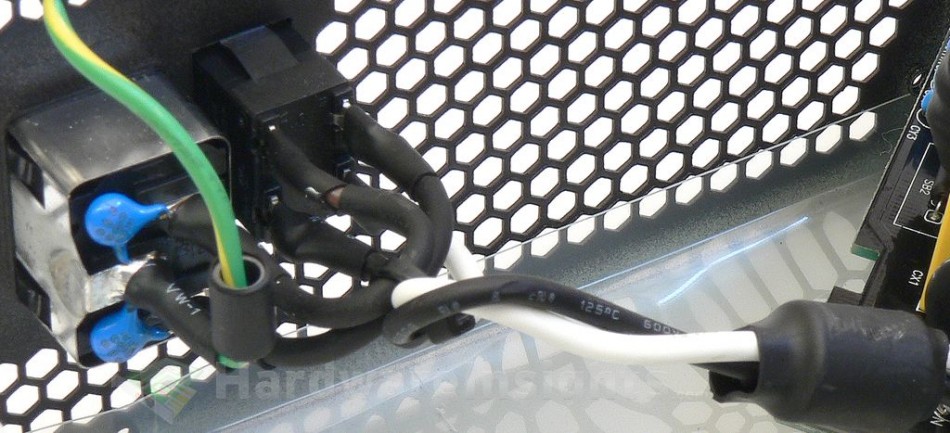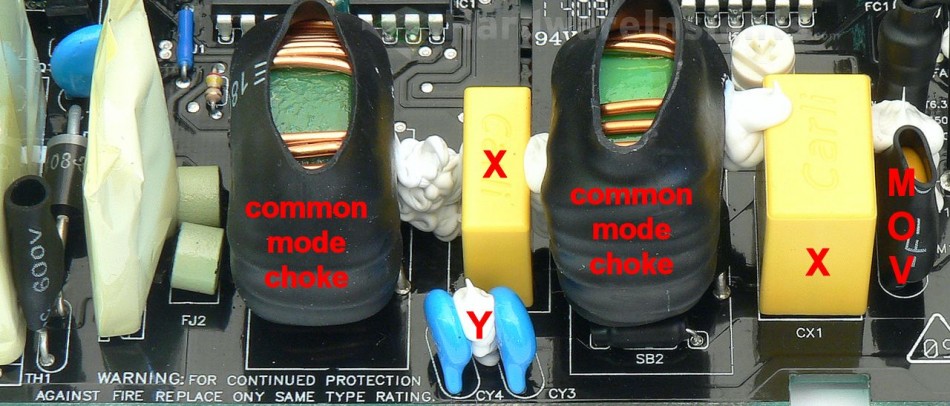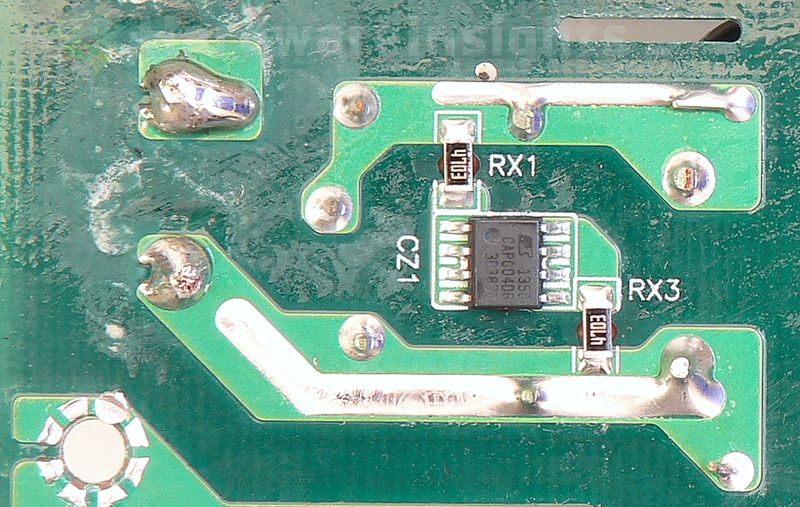Contents
- 1Introduction
- 1.1Packaging and accessories
- 2Connectors & cabling
- 2.1Casing & cooling
- 3Input filtering
- 4Primary side
- 4.1+5 V stand-by rail
- 5Secondary side
- 5.1Build quality
- 6Load testing
- 6.1Loading +5 V SB
- 6.2Voltage hold-up time
- 6.3Combined loading
- 6.4Combined loading ripple
- 6.5Crossloading, overloading
- 6.6Crossloading, overloading ripple
- 7Conclusion and evaluation
- 7.1Thanks
- 7.2Discussion
Input filtering
The input filtration – as usual – starts directly on the AC inlet with two ceramic Y capacitors. There is a ferrite bead on the earth/ground wire and also phase+neutral wires go through one more bead on the way from double-pole switch towards the main board. The inlet itself is partially shielded.
 Then there are two more Y caps on the main board (and fifth between primary and secondary sides) together with two X film caps, two common-mode chokes and also two ferrite beads (for both neutral and phase). The varistor (MOV) is on the very input next to the fuse, thermistor on the other hand is just after input rectifier. Both sleeved with heatshrink, as well as the chokes.
Then there are two more Y caps on the main board (and fifth between primary and secondary sides) together with two X film caps, two common-mode chokes and also two ferrite beads (for both neutral and phase). The varistor (MOV) is on the very input next to the fuse, thermistor on the other hand is just after input rectifier. Both sleeved with heatshrink, as well as the chokes.  We also have the Power Integrations CAP004DG chip for intelligent discharging of X capacitors to avoid constant waste of power.
We also have the Power Integrations CAP004DG chip for intelligent discharging of X capacitors to avoid constant waste of power.  X capacitors (between phase and neutral) and Y (between phase and ground/neutral and ground, often also between one side of the high-voltage DC and ground) are used to filter out high-frequency ripple from power grid (often from devices which lack filtration because of cost cutting, but also from devices where filtration is very difficult to implement) and also keeps ripple from this unit from entering the grid. Chokes are used for the same reason, together they form an input filter. These components may also (partially) help to filter smaller voltages spikes in the power grid while the MOV is used to suppress more serious spikes (for example from lightning hitting the power grid at a distance). These days, more Y capacitors are used even between rectified ground (ground after an input rectifier) and earth ground to suppress internal interference and keep it from getting to secondary side, because really high-frequency ripple goes everywhere it can to some extent (including coupling through the insulation, metal casing etc.). That is also why the AC wires themselves are often inserted through the ferrite core.
X capacitors (between phase and neutral) and Y (between phase and ground/neutral and ground, often also between one side of the high-voltage DC and ground) are used to filter out high-frequency ripple from power grid (often from devices which lack filtration because of cost cutting, but also from devices where filtration is very difficult to implement) and also keeps ripple from this unit from entering the grid. Chokes are used for the same reason, together they form an input filter. These components may also (partially) help to filter smaller voltages spikes in the power grid while the MOV is used to suppress more serious spikes (for example from lightning hitting the power grid at a distance). These days, more Y capacitors are used even between rectified ground (ground after an input rectifier) and earth ground to suppress internal interference and keep it from getting to secondary side, because really high-frequency ripple goes everywhere it can to some extent (including coupling through the insulation, metal casing etc.). That is also why the AC wires themselves are often inserted through the ferrite core.

